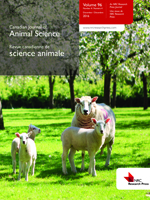Greter, A. M., AlZahal, O., Duffield, T. F., McBride, W. B., Widowski, T. M. and DeVries, T. J. 2014. Effect of frequency of feed delivery on the feeding behaviour, growth, and rumen temperature of limit-fed dairy heifers. Can. J. Anim. Sci. 94: 11-20. The objective of this experiment was to determine the effect that frequency of provision of feed, provided in a restricted amount, had on feeding and lying behaviour, growth, and rumen temperature of growing dairy heifers. Twenty-four Holstein heifers (178.2±9.3 d of age; mean±SD), divided into six groups of four, were assigned to each of three treatments using a 3×3 Latin square design with 28-d periods (21-d adaptation, 7-d data collection). Treatments were delivery of daily allotment of total mixed ration (fed at 2.0% of body weight): (1) once per day (1×; 0800), (2) twice per day (2×; 0800 and 1600), and (3) four times per day (4×; 0800, 1200, 1600, and 2000). Average daily gain (ADG) was similar across treatments (0.8 kg d-1). There was a tendency for within-pen variation of ADG (average, per pen, of the absolute difference between individual heifer ADG and pen mean ADG) to be greater with 4× (0.3 kg d-1) and 2× (0.3 kg d-1) compared with 1× (0.2 kg d-1). Both feeding (63.1 vs. 44.2 vs. 51.5 min d-1) and unrewarded (presence at the feed bunk when no feed was present; 49.5 vs. 27.7 vs. 33.1 min d-1) time at the feed bunk decreased with increasing frequency of feed delivery (1×, 2×, and 4×, respectively). Frequency of displacements (3.1 displacements d-1) and number of displacements per unit of feeding time (0.06 displacements min-1) were similar between treatments. Lying time was similar between treatments (802.5 min d-1), while there was an increase in the amount of time spent standing without eating as frequency of feed delivery increased (558.9 vs. 590.0 vs. 604.7 min d-1 for 1×, 2×, and 4×, respectively). Thus, feeding 1× d-1 may prove beneficial for limit-fed heifers as it increases the time spent feeding, and decreases time spent standing without eating and within-pen variation in ADG.
How to translate text using browser tools
2 October 2013
Effect of frequency of feed delivery on the feeding behaviour, growth, and rumen temperature of limit-fed dairy heifers
A. M. Greter,
O. AlZahal,
T. F. Duffield,
B. W. McBride,
T. M. Widowski,
T. J. DeVries
ACCESS THE FULL ARTICLE
It is not available for individual sale.
This article is only available to subscribers.
It is not available for individual sale.
It is not available for individual sale.
alimentation limitée
comportement alimentaire
Dairy heifer
feeding behaviour
feeding frequency
fréquence de distribution des aliments
Génisses laitières





